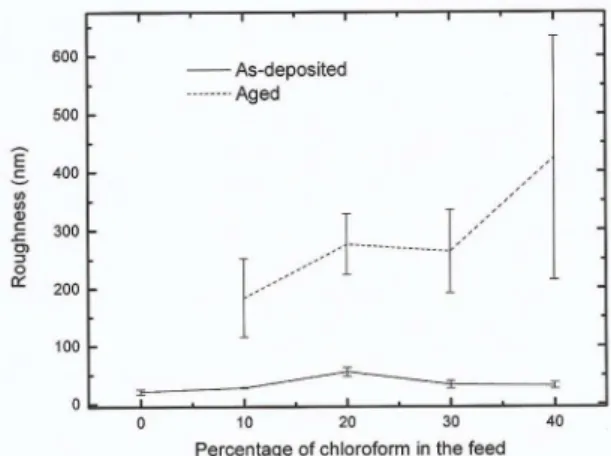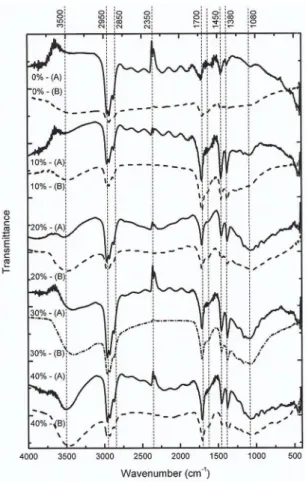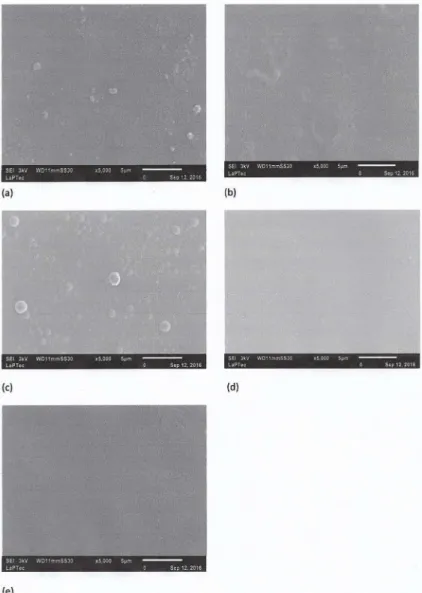DOI: http://dx.doi.org/10.1590/1980-5373-MR-2016-0667
Materials Research. 2017; 20(4): 862-865 © 2017
Efects of Aging on Chlorinated Plasma Polymers
Rafael Gustavo Turria, Milena Kowalczuk Manosso Amorima, Tayan Vieira Hadicha, Isabela Cristina Fernandesa, Gabriel Ferreira Fernandesa, Diego Rossia, Elidiane Cipriano Rangela,
Steven Frederick Durranta*
Received: September 14, 2016; Revised: November 21, 2016; Accepted: January 03, 2017
Thin ilms deposited from propanol-chloroform-argon mixtures by plasma enhanced chemical vapor deposition at diferent partial pressures of chloroform in the feed, CCl, were characterized after two years of aging and their characteristics compared with their as-deposited properties. Film thickness decreased and surface roughness increased with aging. Surface contact angles also increased with aging for the chlorinated ilms. For the ilm deposited with 40% chloroform in the feed the contact angle increased about 14°. Transmission infrared and Energy dispersive X-ray spectroscopy revealed that the ilms gain carbonyl and hydroxyl groups and lose chlorine and hydrogen on aging. Chlorination appears to make the ilms more durable. Delamination was observed for the unchlorinated ilms.
Keywords: thin ilms; a-C:H:O:Cl; IRS; stability; contact angle
* e-mail: steve@sorocaba.unesp.br
1. Introduction
Although some studies have been made on amorphous hydrogenated carbon ilms containing chlorine1-3 there is still a relative dearth of literature dealing with such materials. Here, a-C:H:O:Cl ilms deposited from plasmas fed propanol, chloroform and argon1 and aged for two years are characterized to investigate
any morphological, structural and compositional changes. In the present investigation, ilm thickness and surface roughness were studied using Proilometry. Surface contact angles were measured using goniometry. Chemical structure and composition are examined using Transmission infrared spectroscopy and Energy dispersive X-ray spectroscopy, respectively. Surface features of the aged ilms were examined using Scanning electron microscopy.
2. Experimental
2.1 Film Production
Details of the depositions are given in the literature1.
In brief, ilms were produced by the PECVD of propanol-chloroform-argon mixtures at constant total pressure, and partial pressures of chloroform of 0 to 40%. As the proportion of chloroform in the feed was increased the proportion of argon was correspondingly decreased.
2.2 Characterizations
Film thickness was measured using a proilometer on samples deposited onto smooth glass plates containing a
ilm step-height delineated during the deposition process with the aid of a mask. Nine horizontal scans of 2000 μm length obtained with a Veeco Dektak 150 proilometer were taken. Surface roughness, Ra, was calculated from these
data for each ilm.
Surface wettability was determined from contact angle (θ) data taken using a Ramé-Hart 100 goniometer. These measurements were conducted immediately after deposition and two years later. The samples were stored for ageing under ambient atmospheric conditions for two years. Three drops of deionized water (0.2 µL) were deposited on diferent regions of the sample surface and the contact angle was measured 10 times on each side of the drop, resulting in sixty θ values per sample.
A Jasco FTIR-410 spectrophotometer was used for transmission infrared spectroscopy in the 4000 to 400 cm-1 range. Each spectrum comprised 128 scans; a resolution of 4 cm-1 was achieved.
Images of the aged ilms were obtained using a Jeol JSM-6010LA scanning electron microscope equipped with a secondary electron detector. Chemical composition of the aged ilms was studied using EDS.
3. Results and Discussion
Figure 1 shows the ilm thickness as a function of the percentage of chloroform in the feed, CCl. The aged ilms tend to be thinner perhaps owing to the loss of chlorine as discussed below. Decreases of around 10% have been observed in the aging (-40 days) of a-C:H:O ilms (where a-preix indicates
a Laboratório de Plasmas Tecnológicos, Instituto de Ciência e Tecnologia de Sorocaba, Universidade
863 Efects of Aging on Chlorinated Plasma Polymers
Figure 1: Film thickness as a function of CCl for the as-deposited
and aged ilms.
amorphous) produced from acetone plasmas4. Apart for the
absence of chlorine, these ilms have chemical compositions similar to the ilms examined in the present study. For the most chlorinated ilms in the present study, which were obtained at CCl of 30% and 40%, the relative thickness decreases were roughly 30% and 13%, respectively. The condition of the aged unchlorinated ilm prevented its thickness from being reliably measured. However, the ilm deposited at CCl = 10%, and therefore having very low chlorine content, sufered a decrease in thickness of around 8%, compatible with the value of 10% cited above for a-C:H:O ilms.
Figure 2 shows the surface roughness, Ra, as a function
of CCl. The aged ilms are consistently and considerable rougher than the as-deposited material, Ra increasing from
around 50 nm to more than 200 nm for the aged ilms. This may be due to the strong de-chlorination and increase in oxygen-containing functionalities as revealed by the infrared and elemental analyses discussed below. (The roughness of the unchlorinated ilm could not be reliably measured.)
Figure 3 shows the surface contact angle as a function of CCl. There is a clear tendency to greater contact angles with aging for the originally more chlorinated ilms. For the ilm deposited at a CCl of 40%, the surface contact angle increases from ~72° to ~86°. The increase in the presence of polar oxygen-containing groups with aging would be expected to decrease the contact angle but the considerable increase in roughness (Figure 2) tends to increase it. The magnitude of the contact angle is similar to those obtained for a-C:H:Cl ilms containing considerably more chlorine (~45 at.%), for which the contact angles were about 77° 2.
Figure 4 shows transmittance spectra of pairs of ilms (as-deposited and aged) produced at CCl (percentage of chloroform in the feed) of 0, 10, 20, 30 and 40. All spectra show absorptions at 2950, 2900 and 2850 cm-1, respectively, due to CH, CH2 and CH3. Similarly, owing to CH2 and CH3
groups, all the spectra show absorptions centered around
Figure 2: Surface roughness as a function of CCl for the as-deposited
and aged ilms.
Figure 3: Surface contact angle as a function of CCl for the
as-deposited and aged ilms.
1450 and 1380 cm-1. All spectra also exhibit a characteristic absorption at around 1700 cm-1, attributed to the presence of stretching in C=O groups. Inspection of Figure 4 reveals that the peak heights of the absorptions due to C=O increase in the aged ilms compared to the peaks due to CHx.
The spectra of the aged chlorinated ilms show a clear absorption at ~1080 cm-1 due to –C-O groups in a primary alcohol. The peak heights of the –C-O absorption tend to increase compared to those due to CHx as the proportion of chloroform in the feed increases.
An absorption at ~3500 cm-1, attributed to the presence of hydroxyl groups, increases as CCl increases, and also tends to be greater for the aged sample in each sample pair.
Turri et al.
864 Materials Research
Figure 4: Transmission infrared spectra in the 400 to 4000 cm-1 range
of pairs of ilms, (A) as-deposited, (B) aged, as a function of CCl.
occur in seconds, it can apparently also continue slowly thereafter on a scale of months or years.
A shoulder to the lower frequency side of the 1700 cm-1 peak (at ~1650 cm-1) is more clearly visible in the aged ilms, and is attributed to the presence of C=C bonds, which are not present in molecules of the monomers or comonomers (propanol and chloroform). These likely result from dehydrochlorination, which is known to occur in the aging of conventional poly(vinyl) chloride8.
Table 1 shows the elemental compositions (C, O, Si and Cl) of the original and aged ilms as determined by XPS and EDS, respectively. The latter analyses are more characteristic of the bulk compositions. The concentration of oxygen at the surface of the original ilms is typically higher than in the bulk. Hence the lower concentrations registered for oxygen of the aged ilms relect this fact. The infrared spectra discussed above indicate a relative increase in oxygen-containing functionalities upon aging. Chlorine, which is dispersed in the bulk, is clearly lost with aging.
The aged unchlorinated ilm showed signs of delamination and appeared to dissolve when exposed to water droplets. A tiny contamination with Si, possibly present in the substrate, was observed for this ilm.
Scanning electron micrographs of the aged ilms are shown in Figure 5 (a to e). The surface of the aged ilm deposited without chloroform (Figure 5a) appears irregular and particulate material is present. In Figure 5c spherical particulate matter with a range of diameters of 1 μm or less is observed. On the same scale the ilms grown at the highest CCl (Figures. 5d and 5e) appear more uniform. Visually the unchlorinated ilm showed some delamination and the more chlorinated ilms a more uniform coverage.
4. Conclusions
On aging over two years under ambient conditions, chlorinated amorphous plasma ilms are oxidized, possess greater densities of OH, C-O, C=O and C=C bonds, and sufer dehydrochlorination. In addition, ilm thickness decreases while surface roughness and the surface contact angle increases. The chlorinated ilms tend to be more stable, resistant to delamination, and present a more uniform aspect in electron microscopy images.
5. Acknowledgements
The authors thank FAPESP (2014/21594-9) and CNPq for inancial support. Two of us (TVH and ICF) acknowledge support from UNESP (Bolsa Reitoria).
Table 1. Elemental composition (at.%) as a function of CCl, the percentage of chloroform in the feed, for the as-deposited and aged ilms. Data for as-deposited ilms were previously published in ref1.
Element C O Si Cl
CCl (%) As-deposited Aged As-deposited Aged As-deposited Aged As-deposited Aged
0 88.7 90.4 11.3 8.1 -- 1.3 -
-10 82.2 90.6 11.1 9.1 -- 0.04 2.7 0.3
20 81.4 88.9 12.4 10.1 -- -- 6.3 1.0
30 80.2 88.9 12.2 8.4 -- -- 7.6 2.7
865 Efects of Aging on Chlorinated Plasma Polymers
Figure 5: Scanning electron microscopy images of the aged ilms at CCl values of (a) 0%,
(b) 10%, (c) 20%, (d) 30%, (e) 40%.
6. References
1. Rossi D, Schreiner WH, Durrant SF. Characterization of amorphous hydrogenated chlorinated plasma polymers. Surface and Coatings
Technology. 2016;289:118-223.
2. Turri R, Davanzo CU, Schreiner W, Silva JHD, Appolinario MB, Durrant SF. Structural and optical properties of chlorinated plasma polymers. Thin Solid Films. 2011;520(5):1442-1445. 3. Turri RG, Santos RM, Rangel EC, da Cruz NC, Bortoleto JRR,
Silva JHD, et al. Optical, mechanical and surface properties of amorphous carbonaceous thin ilms obtained by plasma enhanced chemical vapor deposition and plasma immersion ion implantation and deposition. Applied Surface Science. 2013;280:474-481.
4. Drabik M, Celma C, Kousal J, Biederman H, Hegemann D. Properies of a-C:H:O plasma polymer ilms deposited from acetone vapors. Thin Solid Films. 2014;573:27-32.
5. Morosof N, Crist B, Bumgarner M, Hsu T, Yasuda H. Free Radicals Resulting from Plasma Polymerization and Plasma Treatment. Journal of Macromolecular Science: Part A –
Chemistry. 1976;10(3):451-471.
6. Yasuda H, Bumgarner MO, Marsh HC, Morosof N. Plasma polymerization of some organic compounds and properties of the polymers. Journal of Polymer Science Part A: Polymer
Chemistry. 1976;14(1):195-224.
7. Stundžia V, Bílková P, Biederman H, Slavínská D, Hlídek P. Electrical properties of plasma-polymerized C:H ilms. Vacuum. 1998;50(1-2):23-25.


